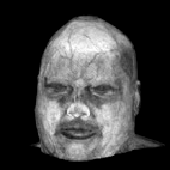 Just a comment triggered by the announcement for the 3rd annual graduate student conference at the Department of Comparative Literature, Stanford University, 10-11 April 2009 on the theme avatars, personae, heteronyms and pseudonyms.
Just a comment triggered by the announcement for the 3rd annual graduate student conference at the Department of Comparative Literature, Stanford University, 10-11 April 2009 on the theme avatars, personae, heteronyms and pseudonyms.
The organisers take the Sanskrit word avatāra as their point of departure (in Hindu theology, an avatar is a deity that descends into a lower realm, i.e., what Xians call an incarnation): “How do we make ourselves visible, or readable, to the world at large? How do we portray or define ourselves to ourselves?”:
The virtualization of certain areas of our societies has provided new fora for experimenting with and reflecting on the images we construct and project, the personae we mimic and adopt, and the ways in which we interact with each other. That said, virtual culture may merely highlight issues that have emerged in different forms through visual art and literature both transnationally and transtemporally: for example, the use of gender-altering pseudonyms as a method of alternative self- representation; the adoption of myriad personae as a tool in artistic creation and performance; and the veneration of icons both religious and social.
Accordingly, the conference is proposed to deal with “the various descents, ascents, descendants and ascendancies of the avatar, as well as the various representational iterations of alternate or constructed personae, such as pseudonyms”, i.e. papers might include topics like:
- oracles and prophets
- icons as objects, icons as people
- masks
- poetic personae
- literary hoaxes; invented authors and their reception
- ghostwriters
- female writers with male pseudonyms and vice versa
- gender, performance, corporeality, drag, self-portraiture
- digital personae; dystopic/utopic movement toward the virtual
- archetypes (Jungian, etc.)
- “personality” or celebrity self-construction, “avatars” of human ideals, cultural “icon” worship, public personae and the culture of self-representation
- orality vs. textuality; textual history & hermeneutics
- hiding/obscuring vs. highlighting/exaggerating
For some reason it all reminds my of Richard Satava’s late 1990s notion of ‘medical avatar’. Satava — who had been in charge of the US Defense Advanced Research Project Agency’s (DARPA) combat care program and later their telemedicine project — had a vision of a multi-dimensional 3D-scanner representation of the whole body, which recorded all possible kinds of patient data — brain waves, blood flow, heartbeat, inner organ structure etc. — in real time:
The patient will walk through a doorway, like the security scanner at an airport, and we will get all the information we need from a true suspended hologram. You can actually feel the beat of the floating heart even though nothing is there
Forget about bloodless avatars in Second Life; Satava’s ‘medical avatar’ was a bloody realistic avatar. The head above (made by Alexander Tsiaras, founder and CEO of AnatomicalTravelogue) is taken from a critical paper by Claudia Reiche where it is accompanied by a quote from Satava:
What you are looking at here is bits and bytes. Zeros and ones. But it’s also a living, breathing, caring human being. This may well be a way to introduce the future to you.
Would be interesting to see if somebody will use the occasion of the Stanford meeting to follow the notion of ‘medical avatar’ through the last ten years of multidimensional medical imaging literature. If so, send an 500 words abstract to avatarsconference@gmail.com by 10 January.
